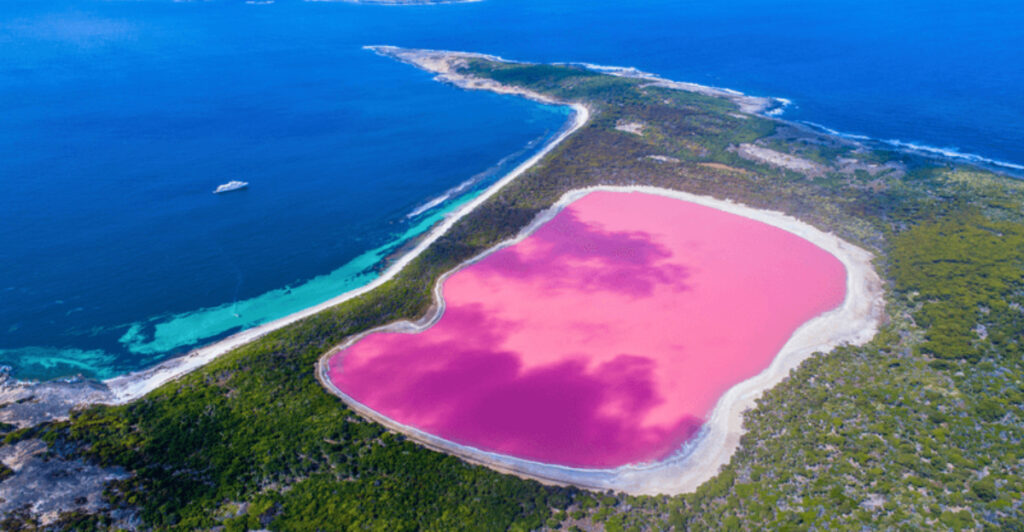Australia holds some of Earth’s most mind-blowing natural treasures that seem almost impossible to believe. From bright pink lakes to rocks that look like frozen waves, this incredible continent showcases nature’s wildest creativity. Many visitors say photos simply cannot capture how amazing these places look in real life. Get ready to discover landscapes so extraordinary they’ll make you question what’s actually possible in our natural world.
1. The Pinnacles Desert (WA)

Walking through this otherworldly landscape feels like stepping onto Mars without leaving Earth. Thousands of limestone pillars stretch across golden sand dunes, creating shadows that dance as the sun moves overhead.
Ancient seashells formed these incredible spires over millions of years through wind and rain erosion. Some towers reach four meters high, while others barely peek above the sandy ground.
Early morning visits offer the most spectacular views when soft light makes each formation glow like ancient monuments. The silence here is so complete you can hear your own heartbeat echoing between the stones.
2. Uluru (NT)
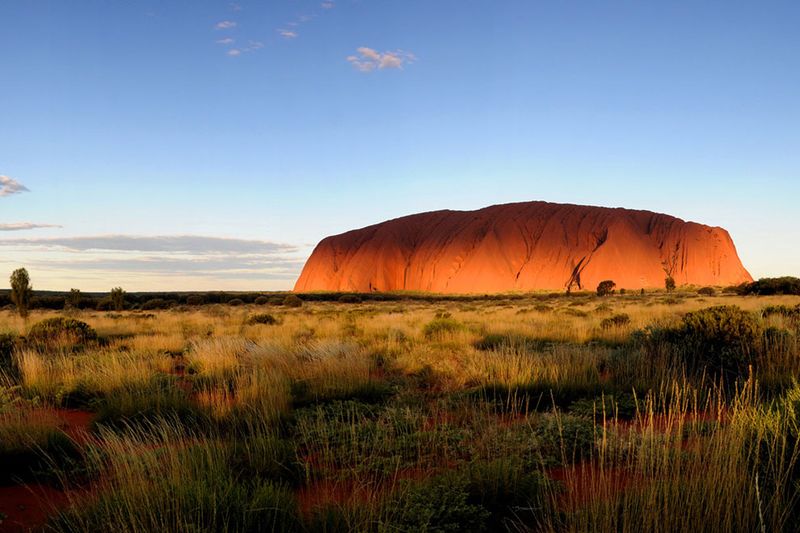
This massive red rock stands 348 meters tall and stretches over three kilometers long, dominating the desert horizon like a sleeping giant. Aboriginal people have considered this sacred site home for over 30,000 years, sharing stories that explain its spiritual significance.
Sunrise and sunset transform Uluru into a glowing beacon that shifts from deep purple to brilliant orange within minutes. The rock’s surface changes color because iron minerals reflect different wavelengths of light throughout the day.
Walking around the base takes about three hours and reveals hidden waterholes, ancient cave paintings, and unique desert plants that somehow thrive in this harsh environment.
3. The Great Barrier Reef (QLD)

Stretching over 2,300 kilometers along Queensland’s coast, this living masterpiece contains more marine species than anywhere else on our planet. Astronauts can actually spot its vibrant colors from the International Space Station, making it Earth’s largest living structure.
Over 1,500 fish species call these coral gardens home, alongside sea turtles, dolphins, and massive whale sharks. The reef system includes 2,900 individual reefs and 900 islands, each supporting unique ecosystems.
Snorkeling here reveals underwater cities where clownfish dart between anemones while parrotfish munch on coral branches. Unfortunately, climate change threatens this wonder, making every visit more precious than the last.
4. Wave Rock (WA)

Nature spent 2.7 billion years sculpting this granite masterpiece that perfectly mimics a massive ocean wave frozen in time. Standing 15 meters high and 110 meters long, this curved cliff face creates an optical illusion that tricks your brain.
Rainwater flowing down the rock’s surface over millions of years created the distinctive wave shape and colorful mineral streaks. Aboriginal people painted handprints and symbols on nearby rocks thousands of years ago, adding human history to geological wonder.
Photographers love capturing brave visitors who appear to surf this stone wave against bright blue skies. The surrounding area also features other fascinating rock formations and seasonal wildflower displays.
5. The Bungle Bungle Range (WA)
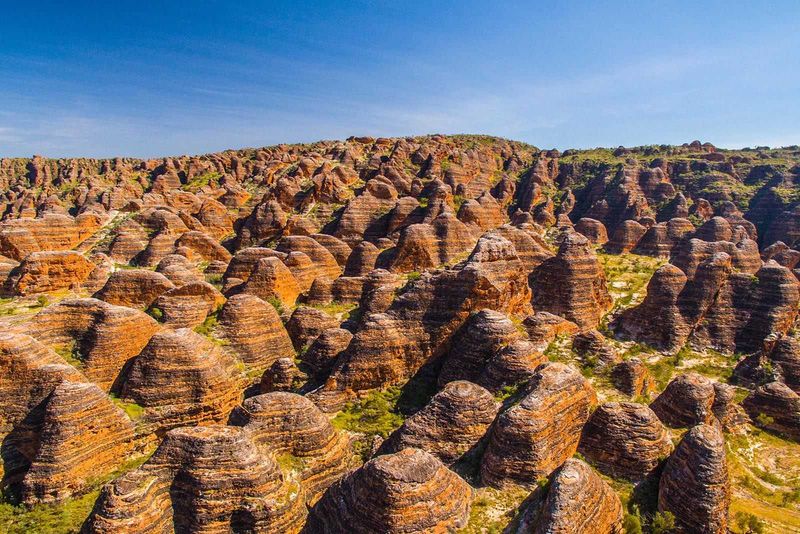
These remarkable beehive-shaped towers look like nature’s own skyscrapers painted with orange and black racing stripes. Each dome formed over 20 million years as sandstone layers compressed and eroded into perfect geometric shapes.
The distinctive banding comes from different mineral layers – orange sections contain iron and silica while darker bands hold cyanobacteria and lichen. Hidden within these formations are narrow gorges, palm-filled pools, and ancient Aboriginal art galleries.
Helicopter tours offer breathtaking aerial views of this striped wonderland, though hiking between the domes provides intimate encounters with unique plants and wildlife. The patterns seem almost too perfect to occur naturally, yet here they stand as geological proof.
6. Whitehaven Beach (QLD)
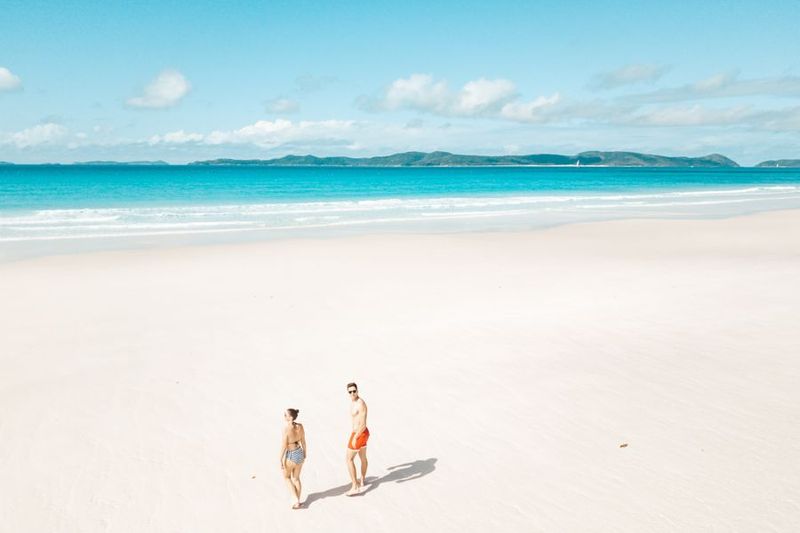
Walking barefoot across this pristine shoreline feels like stepping on powdered sugar mixed with tiny pearls. The sand contains 98% pure silica, making it so fine and white that it actually squeaks under your feet with each step.
This remarkable silica composition keeps the sand cool even during scorching summer days, while the turquoise water creates a color contrast so vivid it seems digitally enhanced. The seven-kilometer beach curves gracefully around Hill Inlet, where swirling tides create natural art patterns.
Seaplanes and helicopters offer stunning aerial views of the swirling sand and water formations that constantly change with each tide. Swimming here feels like floating in liquid crystal surrounded by the purest sand on Earth.
7. The Twelve Apostles (VIC)

Only seven limestone sentinels remain standing today, but these towering sea stacks continue inspiring awe along Victoria’s dramatic coastline. Each formation rises up to 45 meters from the Southern Ocean, shaped by millions of years of relentless wave action.
Originally connected to the mainland cliffs, these giants gradually separated as softer limestone eroded around harder sections. The constant battle between rock and sea continues today, slowly but surely changing their shapes and heights.
Sunset viewing from the wooden boardwalks offers spectacular photo opportunities as golden light illuminates the stacks against crashing waves. Helicopter tours reveal hidden beaches and sea caves that landlubbers never see, adding extra magic to this coastal wonder.
8. Lake Hillier (WA)

This bubblegum-pink lake looks like someone dumped food coloring into ordinary water, but science explains the magical hue. Dunaliella salina algae and Halobacteria produce bright pink pigments that thrive in the lake’s extremely salty conditions.
The 600-meter-long lake maintains its shocking color year-round, creating a surreal contrast against surrounding eucalyptus forests and the deep blue Southern Ocean. Even when you scoop the water into a clear container, it keeps its rosy tint.
Helicopter tours provide the only way most visitors can witness this natural phenomenon since Middle Island restricts ground access. The lake’s salt content rivals the Dead Sea, making it impossible for fish to survive but perfect for these colorful microorganisms.
9. Kati Thanda-Lake Eyre (SA)

Most years this massive salt flat resembles a cracked white desert stretching beyond the horizon, but rare flooding transforms it into Australia’s largest lake. When water arrives from distant Queensland rains, the basin becomes a temporary inland sea supporting millions of waterbirds.
The lake sits 15 meters below sea level, making it Australia’s lowest natural point and creating unique weather patterns. Salt crystals form intricate geometric patterns across the dried surface, while occasional water creates perfect mirror reflections of passing clouds.
Pelican migrations during flood years create one of nature’s most spectacular gatherings as these birds somehow sense water from thousands of kilometers away. The transformation from barren salt to thriving ecosystem happens so rarely that each flood becomes a celebrated natural event.
10. The Blue Mountains (NSW)
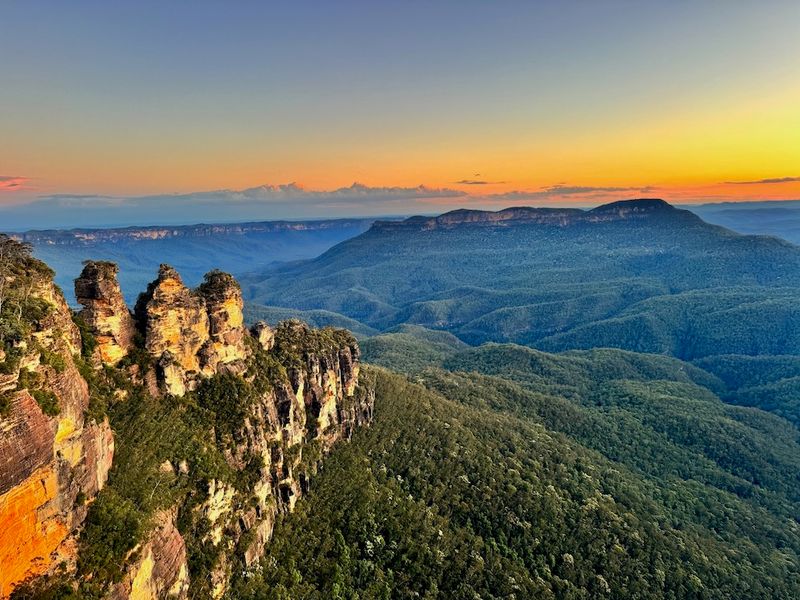
Eucalyptus trees release so much oil into the air here that it creates a distinctive blue haze visible from space. This UNESCO World Heritage region contains over 140 kilometers of cliff faces, deep valleys, and cascading waterfalls that seem to emerge from fairy tales.
The Three Sisters rock formation serves as the area’s most famous landmark, while the scenic railway offers thrilling rides down impossibly steep slopes. Ancient Gondwana rainforest survives in protected gullies, preserving plant species that existed when dinosaurs roamed Earth.
Bushwalking trails range from gentle strolls to challenging multi-day adventures through wilderness areas where you might not see another person for hours. The crisp mountain air and panoramic views provide perfect escapes from Sydney’s urban energy just two hours away.
11. Katherine Gorge (NT)
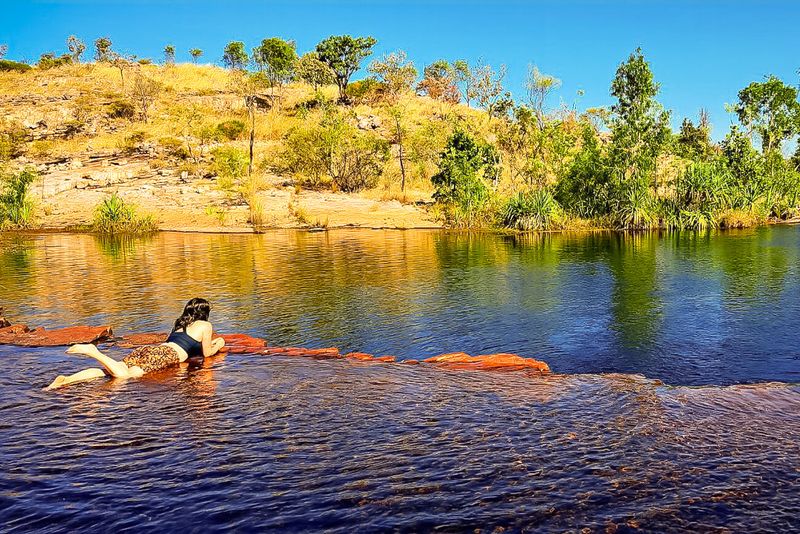
Thirteen separate gorges carved through 1.8-billion-year-old sandstone create a water wonderland in the heart of Arnhem Land. Aboriginal people have lived along these waterways for over 40,000 years, leaving behind rock art galleries that tell ancient stories.
Boat cruises reveal towering red walls reflected in still water, while swimming holes offer refreshing relief from tropical heat. Freshwater crocodiles sunbathe on rocky ledges, though they’re generally harmless to humans unlike their saltwater cousins.
Helicopter flights showcase the gorge system’s true scale as it winds through rugged wilderness for over 12 kilometers. During the wet season, waterfalls cascade down cliff faces, while the dry season exposes hidden beaches and walking trails between sections.
12. The Devil’s Marbles (NT)

Giant granite boulders balance impossibly on tiny contact points, defying gravity in ways that seem to mock physics textbooks. These sacred Karlu Karlu formations hold deep spiritual significance for Warumungu Aboriginal people, who share creation stories explaining their mysterious arrangement.
Each sphere formed underground millions of years ago before erosion exposed them like nature’s own sculpture garden. Temperature changes cause the granite to expand and contract, slowly splitting solid rock into these perfectly rounded shapes.
Sunrise photography sessions reveal how the red granite glows against the desert landscape while shadows emphasize their precarious positioning. Some boulders stand over six meters tall, yet seem ready to roll away with the slightest push, though they’ve remained stable for thousands of years.
13. Horizontal Falls (WA)

Massive tidal forces squeeze billions of liters of seawater through two narrow cliff gaps, creating the illusion of waterfalls flowing sideways. This unique phenomenon occurs twice daily as Kimberley tides – among the world’s largest – rise and fall up to 10 meters.
Fast boat rides through the falls provide adrenaline-pumping experiences as captains navigate the turbulent waters at precisely the right tidal moments. The surrounding ancient reef formations date back 350 million years, making this one of Earth’s oldest landscapes.
Seaplane flights offer spectacular aerial views of the horizontal water flow against red cliff faces and turquoise seas. Aboriginal people have witnessed this natural wonder for thousands of years, incorporating it into their traditional stories about the region’s creation and spiritual significance.
14. The Ningaloo Reef (WA)

While everyone talks about the Great Barrier Reef, this western treasure offers equally stunning coral gardens with one major advantage – you can walk straight from the beach into pristine reef waters. Whale sharks, the ocean’s gentle giants, visit these waters predictably each year.
Swimming alongside 12-meter whale sharks creates unforgettable memories as these spotted behemoths glide gracefully through crystal-clear water. The reef stretches 300 kilometers along Western Australia’s coast, supporting over 500 fish species and 250 coral varieties.
Manta ray encounters happen year-round at cleaning stations where smaller fish remove parasites from these graceful ocean dancers. The reef’s accessibility means snorkelers can explore colorful coral gardens just meters from their beach towels, making it perfect for families and nervous swimmers.
15. The Three Sisters (NSW)
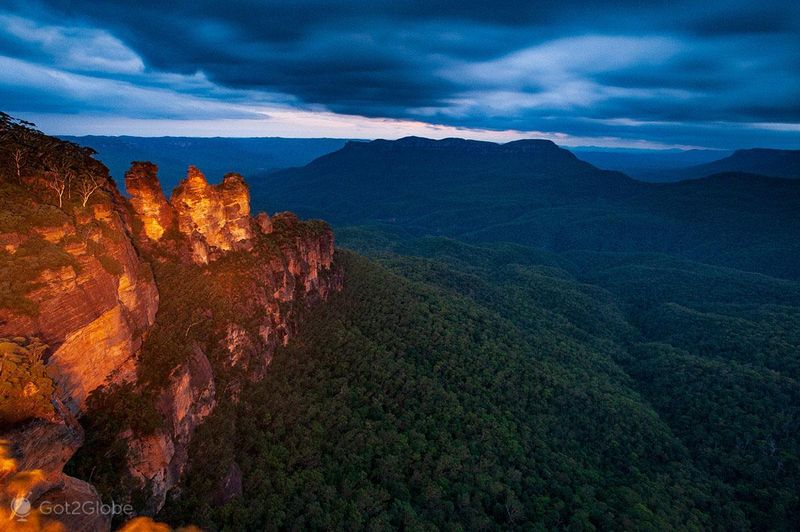
Aboriginal Dreamtime stories tell of three beautiful sisters turned to stone to protect them from unwanted suitors, giving these 900-meter-high sandstone pillars deep cultural meaning. Each formation has its own name – Meehni, Wimlah, and Gunnedoo – honoring the legendary siblings.
The best viewing times occur during sunrise and sunset when the golden light transforms the gray sandstone into glowing amber towers. A skyway cable car carries visitors across the valley for close-up views, while the scenic railway provides thrilling descents into the valley floor.
Rock climbing enthusiasts tackle the challenging faces under strict regulations, though most visitors prefer the walking tracks that offer spectacular valley views. The formations continue slowly eroding, making each generation’s experience slightly different from their parents’ memories of these ancient sentinels.
16. Wilpena Pound (SA)

This massive natural amphitheater stretches 17 kilometers long and eight kilometers wide, creating a hidden world that feels like stepping into a lost continent. Ancient mountain ranges collapsed inward millions of years ago, forming walls that rise 500 meters above the interior valley floor.
Only one natural entrance allows ground access to this geological fortress, while scenic flights reveal the perfect oval shape that early explorers compared to a giant sheep pen or ‘pound.’ Red River gums line seasonal creeks, supporting wildlife that includes yellow-footed rock wallabies.
Aboriginal people lived within these protective walls for thousands of years, leaving behind rock art sites and tool-making areas. The pound’s unique microclimate supports plant species found nowhere else in South Australia, making it a natural laboratory for studying evolution.
17. The Glow Worm Caves (QLD & NSW)
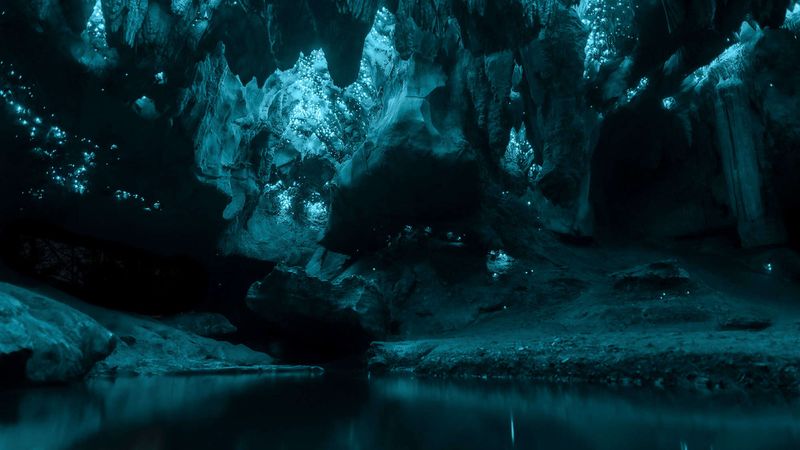
Stepping into these dark limestone caverns reveals thousands of tiny blue-green lights twinkling like an underground galaxy. Arachnocampa larvae create this magical display by hanging silk threads coated with sticky droplets that glow to attract flying insects.
The darker the cave, the brighter the glow worms shine, creating an ethereal ceiling of living stars above underground streams. Boat tours through flooded sections offer the most spectacular views as the lights reflect in still black water below.
Complete silence enhances the experience since noise and camera flashes can stress these delicate creatures into dimming their lights. Natural caves near Brisbane and artificial tunnels in abandoned mines both host these luminous displays, proving that sometimes nature’s most beautiful shows happen in the darkest places.

